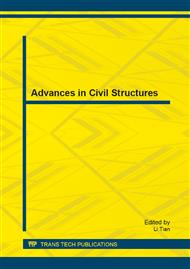p.1389
p.1393
p.1397
p.1404
p.1408
p.1415
p.1419
p.1423
p.1432
Cracking Mechanism and Strengthen Method of Reinforced Concrete Hammerhead Piers
Abstract:
This paper indicates cracking mechanism and strengthening method of reinfoced concrete hammerhead piers. A field investigation phase has been undertaken in conjunction with analytical studies to model the cracking process. It is shown that the front cracks in the pier cap developed because the bending tensile stress far exceeds the tensile strength, while the side crack caused by none bursting reinforcement. Based on the analysis results, an internally prestressing approach is provided, and the retrofitting effect is verified by finite element analysis. Strengthening with internally prestressed tendons of bridge pier cap is proven to be a reliable and relatively easy-to-install technique.
Info:
Periodical:
Pages:
1408-1414
Citation:
Online since:
August 2013
Authors:
Keywords:
Price:
Сopyright:
© 2013 Trans Tech Publications Ltd. All Rights Reserved
Share:
Citation:


